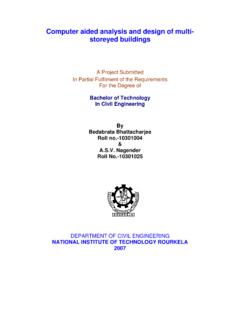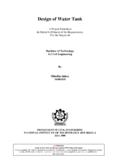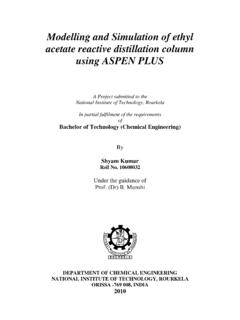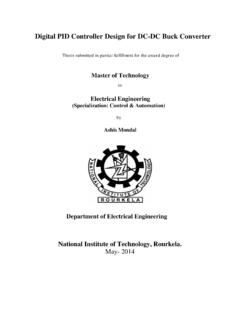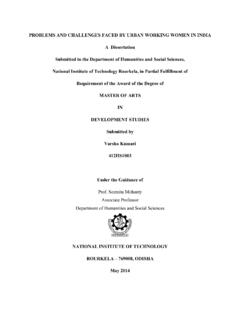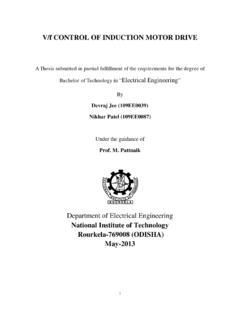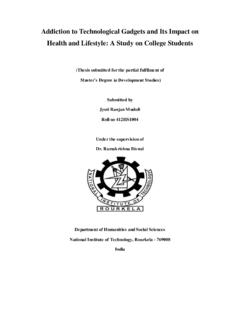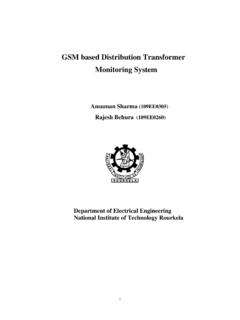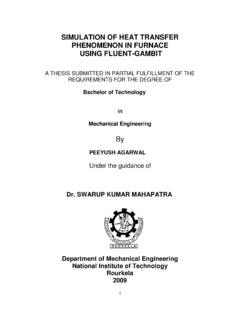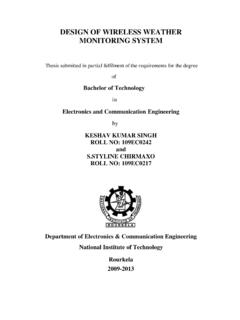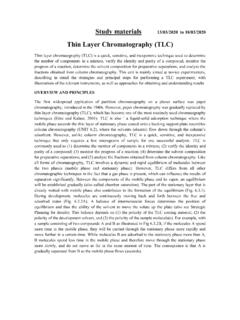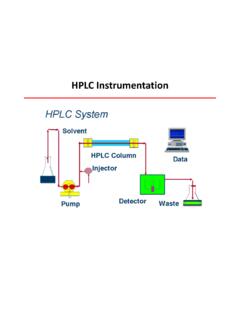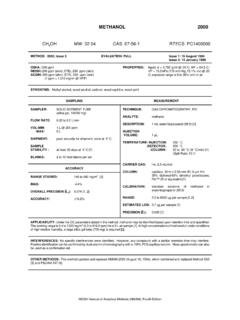Transcription of EXTRACTION OF ESSENTIAL OIL AND ITS APPLICATIONS
1 A Project Report on EXTRACTION OF ESSENTIAL OIL AND ITS APPLICATIONS In partial fulfillment of the requirements of Bachelor of Technology (Chemical Engineering) Submitted By Virendra P. S. Rao (Roll ) Diwaker Pandey (Roll ) Session:2006-07 Under the guidance of Prof. (Mrs) Abanti Sahoo Department of Chemical Engineering National Institute of Technology Rourkela-769008 iOrissa National Institute of Technology Rourkela CERTIFICATE This is to certify that that the work in this thesis report entitled EXTRACTION of ESSENTIAL Oil and its APPLICATIONS submitted by Virendra and Diwaker Pandey in partial fulfillment of the requirements for the degree of Bachelor of Technology in Chemical Engineering Session 2003-2007 in the department of Chemical Engineering, National Institute of Technology Rourkela, Rourkela is an authentic work carried out by them under my supervision and guidance.
2 To the best of my knowledge, the matter embodied in the thesis has not been submitted to any other University/Institute for the award of any degree. Date: Prof. (Mrs.) Abanti Sahoo Department of Chemical Engineering National Institute of Technology Rourkela - 769008 ii ACKNOWLEDGEMENT We express sincere gratitude to our project guide Prof. (Mrs) Abanti Sahoo, Asst professor for her kind support , guidance and constructive criticism in the completion of project.
3 We are thankful to Mr. Singh for his sincerity over the project. We are also thankful to Prof. Pradip Rath, Head of the Department, for providing us the necessary opportunities for the completion of our project. Virendra (Roll No. 10300011) Diwaker Pandey (Roll No. 10300014) Final Yr. Chem. Engg. iii CONTENT Title Page No Figures and Tables v Abstract vi Chapter 1 INTRODUCTION 1-3 Chapter 2 LITERATURE SURVEY 4-23 What are ESSENTIAL Oil?
4 5 What is Aromatherapy? 8 Pharmacological Properties of ESSENTIAL Oil. 9 Chemical Constituents of ESSENTIAL Oil. 10 Methods of Extracting ESSENTIAL Oil. 15 EXTRACTION of ESSENTIAL Oil by using Steam Distillation method 18 Application of oil Extracted from Eucalyptus 21 Chapter 3 EXPERIMENTAL WORK 24-31 Experimental Set-up 25 Experimental Procedure 27 Experimental Observations 28 Analysis of ESSENTIAL Oil( Study ) 29 Chapter 4 RESULTS AND DISCUSSION 32-34 Inferences 33 Chapter 5 CONCLUSION 35 REFERENCES 37-39 iv Figure Contents Title Page No.
5 : Flow diagram for the Steam Distillation 25 : ESSENTIAL Oil Steam Distiller 26 : Flow Diagram for Steam distillation 27 : Chromatographic Analysis of Eucalyptus Oil 30 : Experimental Setup of Gas chromatography 31 : Eucalyptus Oil obtained Vs Time 33 : Eucalyptus Oil obtained Vs Temperature of the water 34 Table Content : Major raw materials used for the EXTRACTION of ESSENTIAL oil 07 : Physical and Chemical Properties of Eucalyptus oil 28 : Chromatographic data of Eucalyptus Oil 30 v ABSTRACT ESSENTIAL oils are highly concentrated substances extracted from flowers, leaves, stems, roots, seeds, barks, resins, or fruit rinds.
6 These oils are often used for their flavor and their therapeutic or odoriferous properties, in a wide selection of products such as foods, medicines, and cosmetics. EXTRACTION of ESSENTIAL oils is one of the most time- and effort-consuming processes. The way in which oils are extracted from plants is important because some processes use solvents that can destroy the therapeutic properties. There are wide number of ways to extract the ESSENTIAL oil but the quality never remains the same. Here we are using the Steam Distillation method for EXTRACTION which is the cheapest way for the EXTRACTION of Oils from the different parts of the plants. In this process steam is allowed to pass through the EXTRACTION chamber which contains plant matter. When steam passes through the herb material under pressure which softens the cells and allows the ESSENTIAL oil to escape in vapor form.
7 The vapour allows to pass through condenser and oil is collected in separating funnel and separated. Composition data for Eucalyptus oil were studied and found the Eucalyptus oil can be used as cosolvent which results in depression of cloud point temperature. vi CHAPTER-1 INTRODUCTION 1 Humankind has used plants for healing for many thousands of years, and it's from this tradition of that the use of aromatic plant compounds is medicine began. Oils were used in the embalming process, in medicine and in purification rituals. There are also over 200 references to aromatics, incense and ointments in the Old and New Testaments; Frankincense, Myrrh, Galbanum, Cinnamon, Cassia, Rosemary, Hyssop and Spikenard are noted for being used for anointing rituals and healing of the sick.
8 Research has confirmed centuries of practical use of ESSENTIAL oils, and we now know that the 'fragrant pharmacy' contains compounds with an extremely broad range of biochemical effects. There are about three hundred ESSENTIAL oils in general use today by professional practitioners. With the continual bombardment of viral, bacterial, parasitic and fungal contamination in our world, ESSENTIAL oils are a great benefit to help protect our bodies and homes from this onslaught of pathogens. Immune system systems need support and ESSENTIAL oils can give it. Because of the enormous amount of raw product used to make wholly natural ESSENTIAL oils, lots of products on the market have been polluted with lower quality, commercial grade oils or contain other chemical substances to reduce the cost or increase the profit margin a fact not usually revealed on the label.
9 This is why it is important to study the chemical composition of the volatile fraction once the ESSENTIAL oil is extracted. This fraction is characterized by the complexity in the separation of its components, which belong to various classes of compounds and which are present in a wide range of concentrations. Therefore it is complicated to establish a composition profile of ESSENTIAL oils. The gas chromatographic method (GC) is almost exclusively used for the qualitative analysis of volatiles. The analysis of ESSENTIAL oils was developed in parallel with the technological developments in GC, such as stationary phases, detection devices, etc. However, advances in instrumentation were not the only important factor in the development of analytical methods for ESSENTIAL oils in plants.
10 Sample EXTRACTION and concentration were also improved . The most outstanding improvements in the determination of the composition of ESSENTIAL oils came from the introduction of tandem 2techniques involving prior/further chromatography or spectroscopy. The great amount of information on the application of GC and hyphenated techniques to ESSENTIAL oils has led to much research in this field. 3 CHAPTER-2 LITERATURE SURVEY 4 What are ESSENTIAL Oils? ESSENTIAL oils are concentrated volatile aromatic compounds produced by plants - the easily evaporated essences that give plants their wonderful scents. Each of these complex precious liquids is extracted from a particular species of plant life. Each plant species originates in certain regions of the world, with particular environmental conditions and neighboring fauna and flora.
